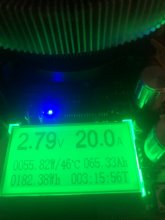First, don't assume what state the cells are in (charged, discharged, or anything else). They need to be fully charged before you can capacity test them. You do this by hooking up a power supply and charging them at exactly 3.65 volts until current going into them drops below 1 amp.
Second, don't be in a hurry, this is a time consuming process.
That little heater you are using, has some known problems. If you run it at 20 amps, you will notice it gets smoking hot, not underneath the heatsink, but right next to the MOSFET is one or two diodes. The one I measured gets over 100 degrees C when running at 20 amps, I highly recommend 10 amps (since these testers also have a habit of letting out magic smoke and creating a dead short). This means 20 hours per cell (did I mention patience?)
Unless you have a BMS, I recommend charging each cell separately, everyone ALWAYS says "I'll pay attention and stop", then we hear about "it was only a few minutes". If you have a BMS and it is set up properly, then you can charge them as a pack until the BMS stops you, that does NOT mean the cells are fully charged, it means A SINGLE CELL is fully charged. So, you will need to then take apart the pack, and charge each cell up to 3.65 volts anyway (since that is the spec for capacity testing). Charging as a pack simply makes it easier and faster to put in a bulk charge, you will have to fill each cell up individually anyway. The specification also says discharge until the cell is at 2.5 volts (that tester has of course voltage drop across the wires you are using, so when it says 2.5 volts on the tester, the cell is actually at 2.7 volts). There is so little capacity at that voltage, I wouldn't even bother to account for that to be honest.
Please explain what you have to charge these with, is it a 10 amp adjustable bench supply like most people use?
I wouldn't go to the trouble of top balancing them yet, since you seem to be concerned you might have gotten a bad cell or two. Plenty of time for that once you have verified capacity (and having the cells empty makes it faster to charge them up as a pack to get ready for top balancing). Putting 10 amps into a 12 or 24 volt pack means 120 or 240 watts, but 10 amps into a 3.65 volt cells is 36.5 watts. This means you can charge 4 or 8 cells from fully discharged in the same time as filling a single cell, but it really only works well if the cells are in the same state of charge.
It may very well be easiest to capacity test them as a pack, but first you need to get all cells at the same state of charge (and from your descriptions so far, nobody has a clue what state they are in).



